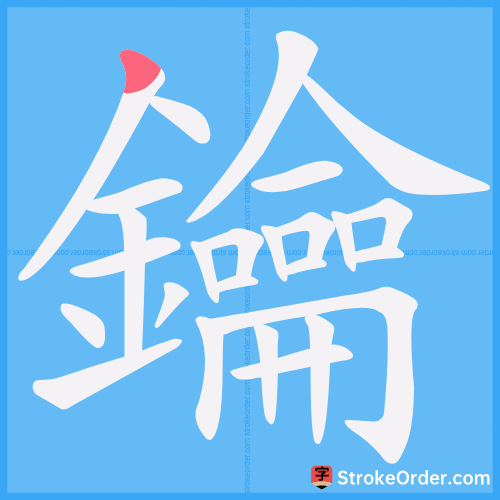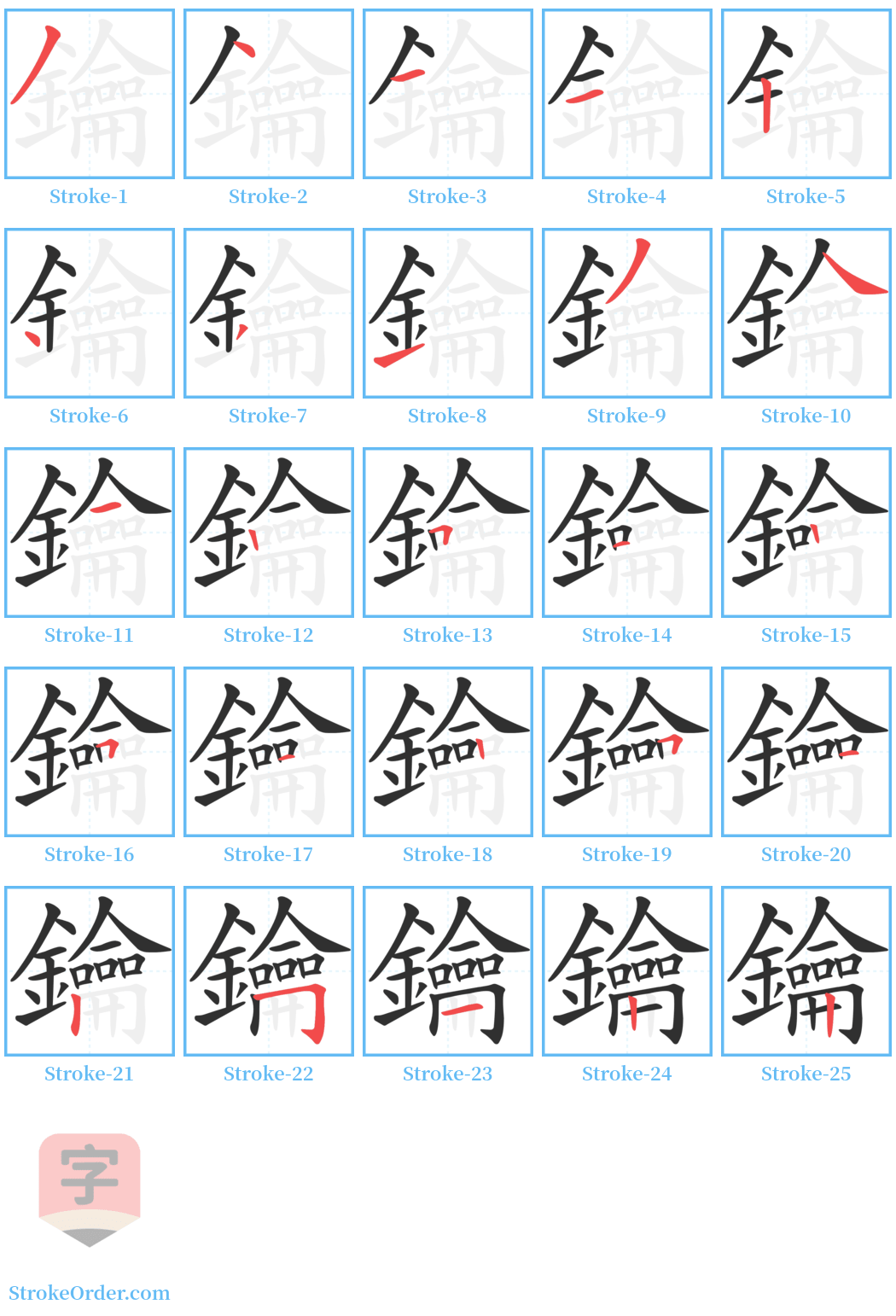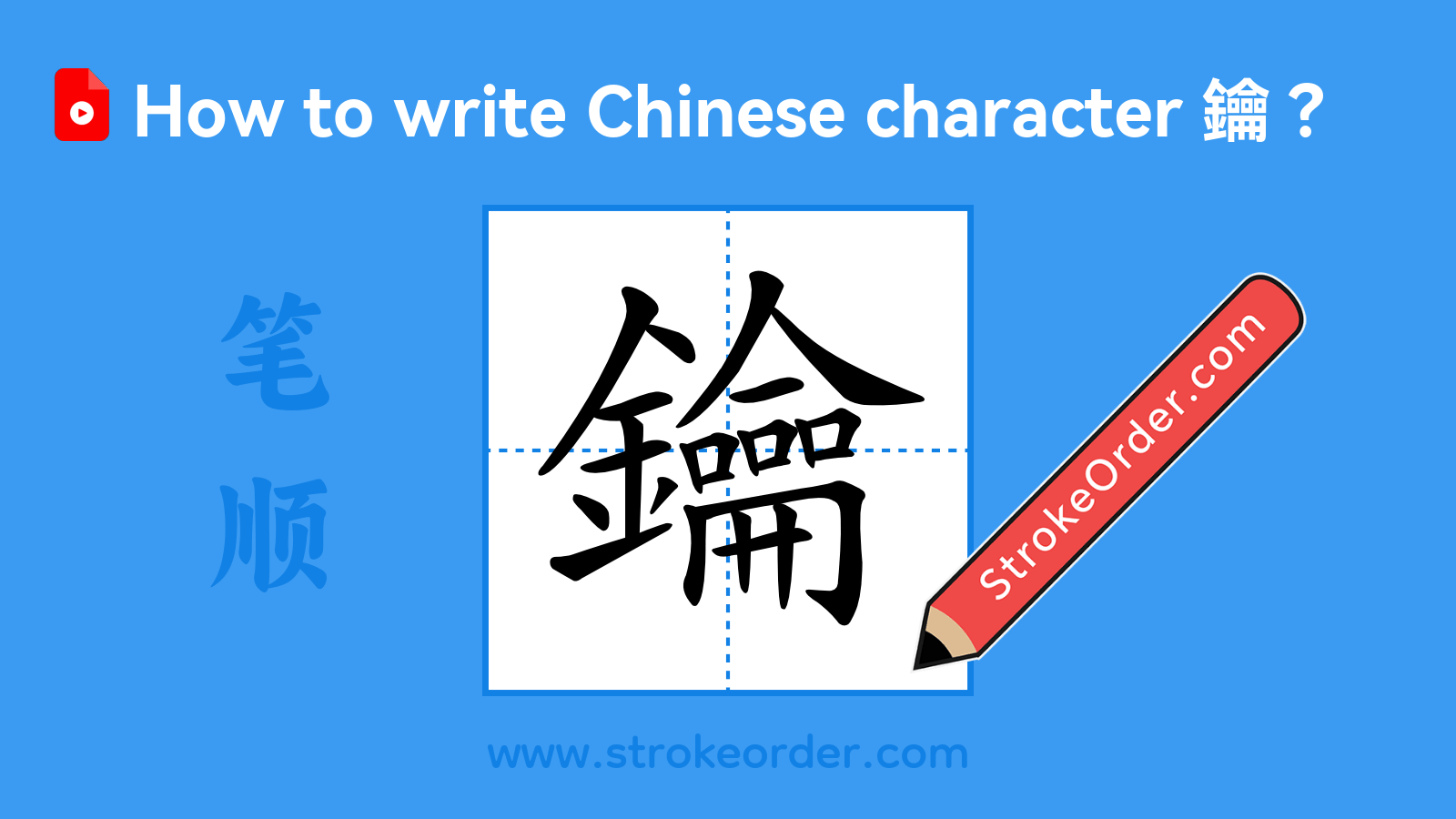鑰 Stroke Order
Animated Stroke Order of 鑰

Stroke Order Diagrams for 鑰

Step-by-Step Handwriting Guide for 鑰

Learn to Write Chinese Characters with Video Tutorials
Watch the video of writing the Chinese character "鑰", learn the correct stroke order (笔顺) of the character "鑰", and master the standard way of writing the character "鑰".

Free Printable Handwriting Practice with Stroke Order: 鑰
Printable Writing Practice Worksheet of "鑰" in Portrait Orientation (Tian Zi Ge)

Printable Writing Practice Worksheet of "鑰" in Landscape Orientation (Tian Zi Ge)

Information of 鑰
Pinyinyuè、 yào
Radical
釒
Strokes
25 strokes
Usage
★★★
Definition
key, key
1. Same as “阖”. A door is directly barred. It is a horizontal beam inserted above the doorway and a straight piece of wood driven into the ground below.2. Lock.3. Key; a tool used to unlock.4. To lock; to close.5. To enter.6. To guard.7. Pivot; metaphorically refers to an important place.8. A surname.1. Same as “阖”. A door is directly barred. It is a horizontal beam inserted above the doorway and a straight piece of wood driven into the ground below. In the fifth volume of 'Dialect', it says: "The door key, when closed to the east, is referred to as 'key' between Chen and Chu; when closed to the west, it is called '鑰'." In 'Ji Yun • Yao Yun': “钥, as stated in ‘Shuo Wen’: 'It is a male below the close.' Some say it is derived from gold.” According to Qing scholar Duan Yucai's notes in 'Shuo Wen Jie Zi', “The closing means a horizontal object, meaning today’s door shutting. 'Closing male' refers to the straight wood driven up above and inserted below.” Therefore, the 'closing male' refers to a key, which is also referred to as '钥'. In ancient times, there were no locks or keys, and it is said they only used wood, not metal.” In 'Xiao Jing • Five Punishments', Zheng Xuan commented: “Opening the human lock is '胫'.” Tang scholar Lu Deming explained: "Sounds like '药'. The character is sometimes written as '鑰'." 2. Lock. In 'Wu Yin Ji Yun • Yao Yun': “钥 is locking.” In 'Zheng Zi Tong • Jin Bu': “A fastener, a key is used to close the door, and a fastener is used to open it; the lock belly needs to be matched; the fastener is inserted to hook and then the key opens.” Additionally, it says: “钥, fish lock.” In 'Zhi Tian Lu': the door lock must be made of fish, taking its meaning of not closing the eyes, signifying guarding at night.” In 'Tai Ping Yu Lan', volume 184, it cites Ying Shao's 'Customs': “The keys suspended are like fish, covering the source, desiring to close the lock in this way.” Qing writer Wu Jianren stated: “Every night must personally close the door's lock, and the key is a high-quality foreign product, and only one key exists; person A wears it. Until the next morning, will the key be personally opened.” 3. Key; a tool used to unlock. In 'Zeng Bu Wu Fang Yuan Yin • Tuo Yun': “钥 is lock key.” Tang writer Zhang Zuo said in 'Chaoye Qian Zai', volume 2: “Yang Tao was a middle court official, it was a time when orders were given fast. An officer holding the treasury key found an old reference book and had to break the window to obtain it.” Tang poet Du Mu wrote in 'Gong Ci': “Silver key withdrawn from the gold lock, the moon brightens and the flowers fall yellow in the dusk.” In 'Zi Zhi Tong Jian • Jin Ming Di Tai Ning Third Year': “The emperor treated him even better, entrusting all palace gate keys to him.” Hu Sanxing added in the notes: “钥...now referred to as lock key.” Zhang Binglin wrote in an address to Bo Zhong Shu (July 2, 1913): “Without a key, please ask the bronze craftsman to open it.” 4. To lock; to close. Beiqi Liu Zhou wrote in 'New Theory • Prevention of Desire': “The germ of desire can be closed by ears and eyes, while the heart can be locked.” Song scholar Luo Dajing wrote in 'He Lin Yu Lu', volume 7: “Stored in a box, locked and placed in the sleeping place.” Lin Shu wrote in 'The Black Slave Appeals to Heaven', two titles, preface: “In recent years, America strictly prohibited Chinese laborers; a wooden fence was set up, gathering hundreds of distant Chinese, fenced and locked.” 5. To enter. In 'Huai Nan Zi • Origin of Tao': “To open the celestial gate.” Gao You noted: “钥 means entry.” 6. To guard. Song writer Xu Mengxing wrote in 'Three Dynasties North Alliance Compilation', volume 248: “Certain person was commanded to serve as keeper of the keys, but had to defend it with death, neglecting other matters.” Song writer Zhou Mi said in 'Qing Dong Ye Yu', volume 9: “Han Wei Gong kept the keys at Beijing…Lu Gong acted as the custodian on behalf of Wei Gong.” 7. Pivot; metaphorically refers to an important place. Tang writer Li Jiao wrote in 'Pan Long Tai Bei': “Holding the keys of the six harmonies, knocking at two instruments’ keys.” In 'Xu Xiake You Ji • Travel Diary of Guangdong West', it says: “There is a village at the foot of the northern mountain, its name is Golden Village, which is the key to the station.” In 'Qing Shi Gao • Yuan Jia San Zhuan', the edict referred to Linhuai as the key between north and south, commanded not to proceed.” 8. A surname. In 'Wan Xing Tong Pu • Yao Yun': “钥, see 'Surname Garden'.” 1. [钥匙] An object used to unlock.2. [钥匙] An object used to unlock, such as: door key; car key. Noun: A tool used to unlock. [Example]: “钥匙.” In 'Zi Zhi Tong Jian, volume 93, Jin Ji 15, Ming Di Tai Ning Third Year': “The emperor treated him even better, entrusting all palace gate keys to him.” Noun: Lock. Song poet Su Shi wrote in 'Watching the Tide on August 15', one of his quatrains: “Sending a message to the heavy door to stop using the key, the night tide remains in the moonlight.”
Input Method for 鑰
Pinyinyue4
Wubi
qeg
Cangjie
opb
Zhengma
pqvv
Four Corner
87720
Unicode
U+9470
Same Pronunciation Characters
吆咬夭妖姚尧摇窑耀肴腰舀药要谣遥邀幺徭曜杳爻珧瑶窈繇鳐鹞垚堯崾搖殽
Same Radical Characters
釒釗釘針釣釦釧釩釵釺鈄鈆鈉鈍鈎鈔鈕鈞鈣鈦鈬鈴鈷鈺鈽鈾鈿鉀鉄鉅鉉鉗鉚
本文来自她们似懂非懂投稿,不代表汉字笔顺中文网英文版立场,如若转载,请注明出处:https://www.strokeorder.cn/strokeorder/14892.html

 微信扫一扫
微信扫一扫 